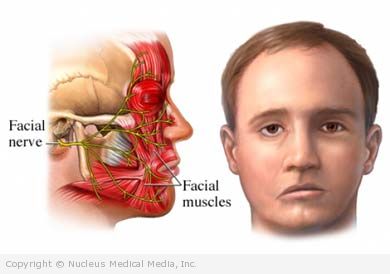Bell’s Palsy – Definition
Bell’s palsy is a sudden weakness and paralysis on one side of the face. It is a temporary condition. Bell’s palsy can occur in anyone but is most common in people with diabetes or those with a recent cold or flu infection.
Bell’s Palsy – Causes
Bell’s palsy is caused by damage to a nerve of the face. The exact cause of this damage is unknown. The damage to the nerve causes swelling along the nerve. The swelling puts extra pressure on the nerve. This extra pressure leads to paralysis of a part of the face.
Some infections are believed to cause some Bell’s palsy. Herpes virus, flu virus, and lyme disease may be associated with Bell’s palsy.
Facial paralysis may also be caused by:
- Head or facial injuries
- Tumors
- Diabetes
- Cancer or infection in the cerebrospinal fluid (CSF)
- Strokes
- Abscess
- HIV
- Infection
- Autoimmune disease
- Drug therapy, such as chemotherapy
- Hereditary diseases
- Other conditions that cause paralysis of the facial nerve
Bell’s Palsy – Risk Factors
Factors that may increase your risk of Bell’s palsy include:
- Family members who have Bell’s palsy
- Pregnancy
- Diabetes
- Cold or flu
- Weakened immune system
- HIV infection
- Smoking
- Hypertension
- Ear infection
- Head or facial trauma
- Cancer history
Bell’s Palsy – Symptoms
Bell’s palsy symptoms may come on suddenly or develop over a few days. Initial symptoms may include:
- Pain behind the ear that is followed by weakness and paralysis of the face
- Ringing sound in the ears
- Slight fever
- Slight hearing impairment
- Slight increase in sensitivity to sound on the affected side.
Symptoms of full-blown Bell’s palsy may include:
- Facial weakness or paralysis (look for smooth forehead and problems smiling)—most often on one side
- Numbness just before the weakness starts
- Drooping corner of the mouth
- Drooling
- Decreased tearing
- Inability to close an eye, which can lead to:
- Dry, red eyes
- Ulcers forming on the eye
- Infection
- Problems with taste
- Sound sensitivity in one ear
- Earache
- Slurred speech
Late complications can occur 3-4 months after onset and can include:
- Long lasting tightening of the facial muscles
- Tearing from eye during eating
Bell’s Palsy – Diagnosis
The doctor will ask about your symptoms and medical history. A physical exam will be done.
Other tests may include:
- Hearing test — to see if nerve damage involves the hearing nerve, inner ear, or hearing mechanism
- Balance test — to see if balance nerves are involved
- Lumbar puncture — a test of the cerebrospinal fluid (CSF) from the lower back; to rule out meningitis, autoimmune disorders, or cancer spreading from a tumor
- Tear test — measures the eye’s ability to produce tears
- CT scan — a type of x-ray that uses a computer to make pictures of structures inside the head to see if there is an infection, tumor, bone fracture, or other problem in the area of the facial nerve
- MRI scan — a test that uses magnetic waves to make pictures of structures inside the head to see if there is an infection, tumor, bone fracture, or other problem in the area of the facial nerve
- Electrical test (NCM/EMG) — to evaluate for damage to the facial nerve
- Blood tests — to check for diabetes, HIV infection, or Lyme disease
Bell’s Palsy – Treatment
For most, treatment is not needed. Symptoms will often go away on their own within a few weeks. Bell’s palsy will completely resolve after a few months in many people. For some people, some symptoms of Bell’s palsy may never go away.
If an underlying cause of the Bell’s palsy is known, it may be treated. Treatment will be based on that condition.
Some treatment that may be used for Bell’s palsy include:
Medication
Your doctor may prescribe corticosteroids. This is a medication that can decrease swelling and pain.
Antiviral medications may also be recommended. This medication will help weaken viruses associated with Bell’s palsy. It will only be used if your doctor believes that palsy is caused by a virus.
Self-care
If the paralysis includes your eyelid, you may need to protect your eye. This may include:
- Appling lubricant or putting drops in the eye.
- Covering and taping eye closed at night.
- Wearing an eye patch to keep the eye closed. This helps moisten and keep particles out of the eye.
Massaging of the weakened facial muscles may also help.
Therapy
Symptoms can be very distressing. Counseling can help you manage emotional issues and make appropriate adjustments.
Physical therapy and speech therapy may also help. Therapists may help reduce your symptoms or decrease their impact on your daily activities.
If you are diagnosed with Bell’s palsy, follow your doctor’s instructions.
Bell’s Palsy – Prevention
There are no guidelines for preventing Bell’s palsy. If you think you are at risk for Bell’s palsy, talk to your doctor. There may be steps you can take to reduce your risk.

